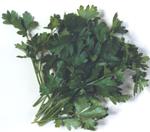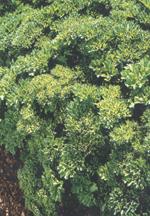| Fruits |
Vegetables
|
Parsley, Petroselinum crispum / Umbelliferae (Apiaceae)
|
Note: Composition for 100 g. of fresh product Values in ( min. - max. ) format. | |
| Energy: 22.00-50.48 kcal Fats: 0.36-1.30 g Fibres: 4.25-5.00 g Minerals Calcium: 200.00-245.00 mgZinc: 0.169-0.700 mg Chlorine: 156.00-160.00 mg Phosporus: 64.00-128.00 mg Iron: 3.20-7.70 mg Magnesium: 23.00-41.10 mg Manganese: 0.20-2.70 mg Potasium: 100.00-760.00 mg Selenium: 1.00-1.40 µg Sodium: 33.00-33.00 mg | Proteins: 3.00-4.43 kcal Carbohidrates: 2.50-7.38 g Liposoluble Vitamins A Retinol: 902.17 µgA Carotenoids: 3350.00-5410.00 µg E or Tocoferol: 1.70-4.81 mg K or Filoquinone: 6200.00-6200.00 µg Liposoluble Vitamins B1 or Thiamine: 0.140-0.280 mgB2 or Riboflavine: 0.056-0.300 mg B3 or Niacine: 0.60-1.00 mg B5 or Pantothenic Acid: 0.300-0.300 mg B6 or Piridoxine: 0.090-0.200 mg B9 or Folic Acid: 166.00-220.00 mg C or Ascorbic Acid: 166.00-220.00 mg |

The parsley may have straight or curled leaves. The straight leaves are mainly used to flavour in cooking, whereas those with curled leaves are used to decorate multiple dishes.
Nutrition and eating
The Greeks already used parsley as medicine for its smooth estrogenic activity and its content of myristicin, which has narcotic and psychomimetic properties. Nevertheless, it was not cultivated for cooking until in the Roman times.
The parsley is rich in minerals like calcium, potassium, phosphorus, magnesium and also iron. It supplies vitamin A and C; nevertheless, the parsley is consumed in small quantities, so it is not the best source of these compounds.
The parsley is rich in minerals like calcium, potassium, phosphorus, magnesium and also iron. It supplies vitamin A and C; nevertheless, the parsley is consumed in small quantities, so it is not the best source of these compounds.
The fruit
 The parsley may have straight or curled leaves. The straight leaves are mainly used to flavour in cooking, whereas those with curled leaves are used to decorate multiple dishes.
The parsley may have straight or curled leaves. The straight leaves are mainly used to flavour in cooking, whereas those with curled leaves are used to decorate multiple dishes.The parsley is consumed mainly fir its leaves, although there are some cultivars that develop a tuberose root that can be consumed; nevertheless, it is hardly used. The parsley is a common seasoning to flavour many dishes, for making multiple sauces, stuffings, omelettes, etc. and as dressing to decorate roasted meat or fish.
It contains a great quantity of vitamin C; 100g of edible fresh weight supplies 166-220mg of ascorbic acid. The leaves are rich in a volatile oil whose active principle is apiol.
The parsley leaves are, according to the variety, strongly divided, smooth and of intense green colour and aromatic, or curled and less aromatic, but highly decorative.
The parsley is harvested in summer and autumn if it is sown at the beginning of spring and in winter if it is sown in the middle of summer. It may be kept up to two months it the temperature conditions and relative humidity are controlled.
The plant

The plant consists of an erect and cylindrical stem, whose leaves are divided in 2 or 3 flat or curled segments; during the second year it bears umbel inflorescences with equal radius.
The leaves are of a bright green colour, with a long petiole and the limb is divided in two or three segments that may be flat or curly according to the variety. The flowers are green, yellowish or reddish and the fruits are small and regarded as seeds.
The leaves are of a bright green colour, with a long petiole and the limb is divided in two or three segments that may be flat or curly according to the variety. The flowers are green, yellowish or reddish and the fruits are small and regarded as seeds.
| Interempresas Media, S.L. / 2025 | [ Legal notice | Política de Protección de Datos | Política de cookies | Publicidad] |
